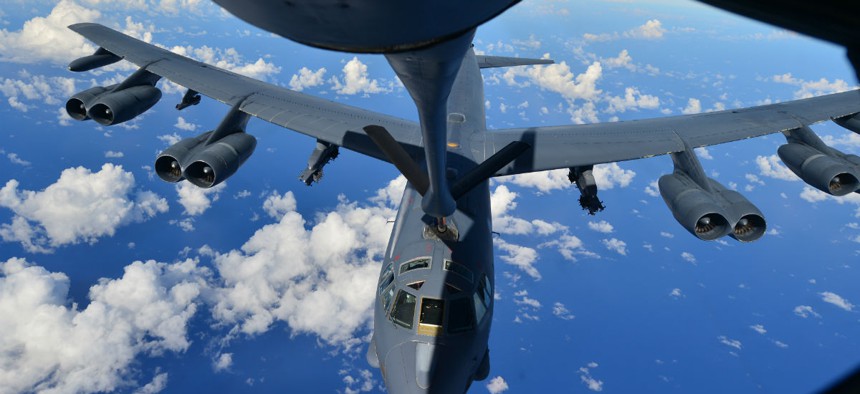Despite Objections, Pentagon Takes Step Toward Buying New Nuclear Weapons
The U.S. Air Force has asked defense firms to bid to supply new ICBMs and controversial nuclear cruise missiles.
The U.S. Air Force took a first step toward buying controversial new nuclear weapons Friday, asking defense companies to submit bids to design and build cruise missiles and ICBMs.
The move comes amid the highest tension with Russia since the end of the Cold War and flies in the face of senators who have called on the Obama administration to cancel plans to build the new cruise missile, called the Long-Range Standoff Weapon, or LRSO.
“The LRSO weapon system will be a cost-effective force multiplier for B-52, B-2, and B-21 aircraft to credibly deter adversaries and assure U.S. allies of our deterrent capabilities,” the Air Force officials said in a statement, referring to the two existing and one planned nuclear-capable bombers.
In the statement, they said they would choose up to two contractors by the fourth quarter of 2017 to build the new cruise missiles. Those two contractors will then compete for 54 months “to complete a preliminary design with demonstrated reliability and manufacturability, which will be followed by a competitive down-select to a single contractor,” the statement said.
A group of 10 senators, all Democrats, have called on the Obama administration to scale back its plans for new nuclear weapons and the bombers and submarines that will carry them. The senators specifically called for canceling LRSO, saying it could save taxpayers $20 billion.
“Nuclear war poses the gravest risk to American national security,” the senators wrote.
The Air Force countered that argument Friday, saying the new cruise missile is necessary to replace its current air-launched cruise missiles, which were designed in the 1970s and built in the 1980s. The Air Force wants the new missiles by 2030.
“LRSO is a critical element of the United States’ nuclear deterrence strategy,” said Maj. Gen. Scott Jansson, commander of the Air Force Nuclear Weapons Center and Air Force program executive officer for strategic systems. “Releasing this solicitation is a critical step toward affordably recapitalizing the aging air leg of the nuclear triad.”
The triad is a reference to the Pentagon’s three nuclear arms, Air Force strategic bombers, intercontinental ballistic missiles and Navy submarines, which carry nuclear missiles.
The Air Force also issues a solicitation Friday to buy new ICBMs to replace the Minuteman, which date back to the 1960s, but have been upgraded over the years. The Air Force calls the replacement project the “Ground-Based Strategic Deterrent.”
“The new GBSD weapon system will meet existing national requirements, while having the adaptability and flexibility to affordably address changing technology and threat environments through 2075,” the Air Force said.
The Pentagon wants to deploy the new ICBMs in the late 2020s.
The Congressional Budget Office last year estimated it would cost about $350 billion to buy new nuclear weapons, ICBMs, stealth bombers, submarines and cruise missiles, between 2015 and 2024 based on the Pentagon's current plans. The total cost of buying all of the new weapons over the next 25 years is estimated at more than $700 billion.
Last October, the Air Force announced it had selected Northrop Grumman to build new stealth bombers that will carry nuclear weapons. The B-2 and B-52 are the Air Force’s two active strategic bombers that can carry both nuclear and conventional bombs. The Navy is in the early stages of buying new submarines, which will replace the Ohio-class subs.
Friday’s announcement comes as Congress is out of session until after the Labor Day holiday in September.




